It looks like you're using an Ad Blocker.
Please white-list or disable AboveTopSecret.com in your ad-blocking tool.
Thank you.
Some features of ATS will be disabled while you continue to use an ad-blocker.
share:
Originally posted by spoor
Similarly, when a mass is lifted up, the force of gravity will act so as to bring it back down. The action of stretching the spring or lifting the mass requires energy to perform. The energy that went into lifting up the mass is stored in its position in the gravitational field, while similarly, the energy it took to stretch the spring is stored in the metal. According to the law of conservation of energy, energy cannot be created or destroyed; hence this energy cannot disappear. Instead, it is stored as potential energy."
en.wikipedia.org...
You seem unable to accept that you know nothing about physics.
No, you are misunderstanding what that is saying as usual. That does not say something at rest has Pe, read it again. For something to have Pe is must be either 'lifted up', stretched, under mechanical load etc. Not at REST.
An object at rest has rest-mass.
Pe is not a body at rest, it is the energy due to it's position, so again the top did not have Pe until it was separated from the rest of the building.
The force that moves the object comes from something else not the object itself, unless it has mechanical properties to move itself, and then the energy comes from that not the object itself. So no energy was created, or destroyed in the object itself, the energy is all external to it. An object at rest only has Pe if its energy state can be lowered. Energy is not created or destroyed because energy is a concept, a way of measuring work done, its not an entity.
A foreboding of problems with this idea that an object can acquire, and have energy is in the arbitrary zero level of gravitational potential energy. We explain this to students as just one of those things that is obviously there because things can fall just so far. By moving a table away from the path of a falling object, or drilling a hole in the floor, we say we can increase the gravitational potential energy that an object has. Here would be an opportunity, missed by most teachers, to explain that potential energy is not something that an object has, but instead refers to a process in which it undergoes a change.
Potential energy simply means something has the potential to do work, and become kinetic energy. If an object is at complete rest there is no potential to create energy, something external has to create the energy to move that object.
You expect complicated explanations, and 'calculations' from 'truthers', yet you can't understand basic physics terms beyond the pedestrian misconceptions of them.
edit on 11/5/2011 by ANOK because: typo
Originally posted by waypastvne
North tower antenna. Less mass above point of collapse.
South tower No antenna. More mass above point of collapse.
Both buildings had approximately the same amount of potential in relation to the center of the earth.
No, because the planes did not hit the same spots. 95th and 81st floors, I believe?
If you mean the whole building, then again wrong.
Pe is based on mass and height (in this case). Gravitational Pe.
Potential energy exists when a force acts upon an object that tends to restore it to a lower energy configuration. This force is often called a restoring force. For example, when a spring is stretched to the left, it exerts a force to the right so as to return to its original, unstretched position. Similarly, when a mass is lifted up, the force of gravity will act so as to bring it back down. The action of stretching the spring or lifting the mass requires energy to perform. The energy that went into lifting up the mass is stored in its position in the gravitational field, while similarly, the energy it took to stretch the spring is stored in the metal.
secure.wikimedia.org...
Again Pe is due to the objects position, it has the potential to do work, the object itself is not full of Pe, you might be though...
edit on 11/5/2011 by ANOK because: typo
Originally posted by ANOK
Again Pe is due to the objects position, it has the potential to do work, the object itself is not full of Pe, you might be though...
Every atom of our planet, including the atmosphere, that does not occupy the gravitational center of the earth has gravitation potential energy. And every atom is looking for any chance it can get to get little closer to that center. That is gravitational potential energy.
Gravitational PE is one of the things that drives our weather in the sea and air. Its most apparent in our atmosphere and we see the battle ragging every day. The air near the surface is heated up, its mass per volume decreases and it rises, the cooler denser air pushes in underneath it to take its place. High altitude cold air can also fall, sometimes quiet dramatically. 50 to 60 miles per hour, its called a micro burst. Tornados and hurricanes are potential converted into kinetic.
So once again to clear up any delusions you may have about GPE.
Every atom that is not at the gravitational center of the earth, has gravitational potential energy.
Its also amusing to see, you don't know which tower is north or south either.
edit on 5-11-2011 by waypastvne because: (no reason
given)
Originally posted by ANOK
For something to have Pe is must be either 'lifted up', stretched, under mechanical load etc
And all the mass of metal, concrete reo etc was lifted up to floor level in the building, so it had PE
You really have no understanding of basic physics.
it is the energy due to it's position, so again the top did not have Pe
You are very confused, the building had Pe due to all the parts being lifted up to build it
An object at rest only has Pe if its energy state can be lowered.
and its energy state is lowered when it falls down....
Potential energy simply means something has the potential to do work, and become kinetic energy.
Thus the building had pe, that was converted to ke when it collapsed....
yet you can't understand basic physics terms
You are the one here unable to understand basic physics!
edit on 5-11-2011 by spoor because: (no reason given)
reply to post by waypastvne
You know something i had typed in the wrong name of the tower...but you also know i have been consistantly talking about the North towers 16 floors .....the one with the big Antenna that your so keen on stating....but it does not change the physics...and thank for finally admitting your wrong because in your statment about you stated that the North tower had 1/2 the kinetic energy as the south tower.....so hey great you know why that is....
Because they had different PE .....DUH!.
but we do not have to play on semantics do we.....we know that you have been wrong and are afraid to admit when your wrong....but unlike you a ican admit when i mis quoted...had typos ...or related misguided informatiom....so yet again you have step in your own poop, thank you for that.
now as for this so call traingaled stuff is that your so call term for cross bracing...as the central core was heavily cross braced all the way up the entire towers.....but you try to say it was the floors that were key tot the collapse...which is a strange way of thinking since the floors were in most steel structures are designed to carry themselves and the loads the floor may carry. THE FLOORS ARE NOT THE SUPPORT.
IT and not going to look but OSer's seem to think the floors pancaked...which NIST itself does not admit....as they only took the collapses as far as initiation....but if they peeled away so easily as yhe OSer's believe then the core structure would remain in tact as the core carries 60% of the load.
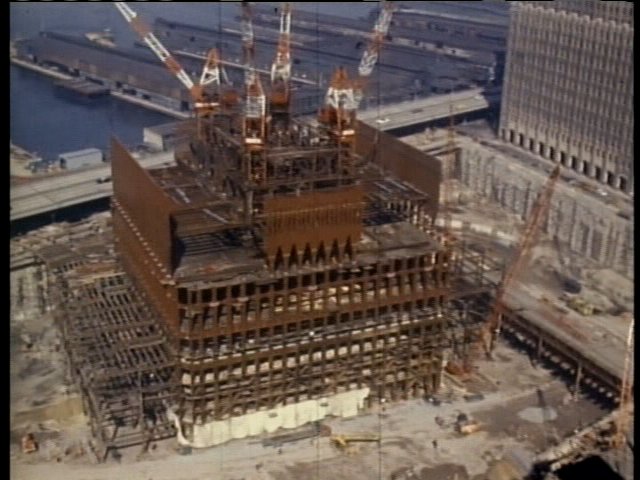
yup no cross bracing there now is there......
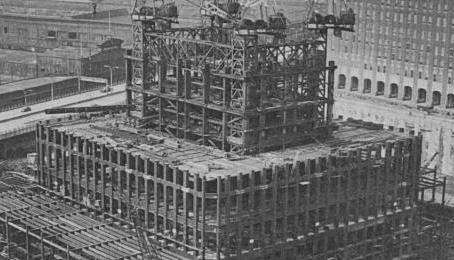
yup no cross bracing there..and i am not just talking abot the crane structures you see sections down the cross bracing which get put in as the structure rise above the ground.....so and because you seen one or two of those steel structures with cross bracing some had more some had less....Why is it so important for you to lie.
But lets look at WTC 4 shall we as much much smaller building...it had hude amounts of debris dumped on it...had raging fires in it had no central core steel framed structure......did it collapse.
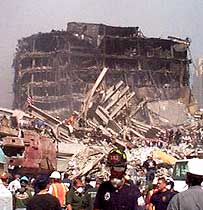
Now before you spit venom because you have beeen pulled and proved to yourself that the KE was in fact different remeber that every mechanical floor was heavily cross braced but of course they had no bearing on the structure itself...it was done just for looks right and because when people design and construct sky scrapers they just like to waste a bunch of unnecessary money.
but just to be clear....did i or did i not state one towers PE would be represented by 16 floors and the other towers would be represented by 27 floors.
As for the ridiculous question of Joeys trying yet again to muddy the waters....it is like crushing a pop can with your foot....i have more than enough energy to stomp on the can and complete the crushing of the can and it might only take say 10j of energy but i had 20j of energy in the crushing of the can....guess where the rest of that energy went........I will let you answer that one cause rather than just present the truth you try to make like people do not understand....yet the title is where you are calling the truthers out but you present lie after lie....so who is projecting more of a dishonest behavior when you cannot even admit when your wrong on a single given point...
WAS THE PE IN ALL THREE COLLAPSES THE SAME .....if you cannot answer that yet again you show your complete and utter ignorance.
You know something i had typed in the wrong name of the tower...but you also know i have been consistantly talking about the North towers 16 floors .....the one with the big Antenna that your so keen on stating....but it does not change the physics...and thank for finally admitting your wrong because in your statment about you stated that the North tower had 1/2 the kinetic energy as the south tower.....so hey great you know why that is....
Because they had different PE .....DUH!.
but we do not have to play on semantics do we.....we know that you have been wrong and are afraid to admit when your wrong....but unlike you a ican admit when i mis quoted...had typos ...or related misguided informatiom....so yet again you have step in your own poop, thank you for that.
now as for this so call traingaled stuff is that your so call term for cross bracing...as the central core was heavily cross braced all the way up the entire towers.....but you try to say it was the floors that were key tot the collapse...which is a strange way of thinking since the floors were in most steel structures are designed to carry themselves and the loads the floor may carry. THE FLOORS ARE NOT THE SUPPORT.
IT and not going to look but OSer's seem to think the floors pancaked...which NIST itself does not admit....as they only took the collapses as far as initiation....but if they peeled away so easily as yhe OSer's believe then the core structure would remain in tact as the core carries 60% of the load.

yup no cross bracing there now is there......

yup no cross bracing there..and i am not just talking abot the crane structures you see sections down the cross bracing which get put in as the structure rise above the ground.....so and because you seen one or two of those steel structures with cross bracing some had more some had less....Why is it so important for you to lie.
But lets look at WTC 4 shall we as much much smaller building...it had hude amounts of debris dumped on it...had raging fires in it had no central core steel framed structure......did it collapse.

Now before you spit venom because you have beeen pulled and proved to yourself that the KE was in fact different remeber that every mechanical floor was heavily cross braced but of course they had no bearing on the structure itself...it was done just for looks right and because when people design and construct sky scrapers they just like to waste a bunch of unnecessary money.
but just to be clear....did i or did i not state one towers PE would be represented by 16 floors and the other towers would be represented by 27 floors.
As for the ridiculous question of Joeys trying yet again to muddy the waters....it is like crushing a pop can with your foot....i have more than enough energy to stomp on the can and complete the crushing of the can and it might only take say 10j of energy but i had 20j of energy in the crushing of the can....guess where the rest of that energy went........I will let you answer that one cause rather than just present the truth you try to make like people do not understand....yet the title is where you are calling the truthers out but you present lie after lie....so who is projecting more of a dishonest behavior when you cannot even admit when your wrong on a single given point...
WAS THE PE IN ALL THREE COLLAPSES THE SAME .....if you cannot answer that yet again you show your complete and utter ignorance.
reply to post by plube
You probably should have gone into more depth. The ambiguous statement combined with your confusion of the towers led us to think WTF is he talking about. Both towers had the same total amount of PE a smaller percentage of that total was turned into KE to initiate the collapse for the north tower. We are in agreement now so drop it.
The finished cores had no X bracing. Sorry. The cranes lifting a load with its arm out away from the building would put an eccentric load on the core columns. The temporary X bracing countered that load after the outer walls were in place the X bracing was no longer needed. They moved the X bracing up as the walls went up.
NIST does indeed admit the floors pancaked. Sorry.
Link
When you crush the can the excess energy will go into the ground. When a floor is "crushed" (truss seats sheared off) the excess energy will go into the next floor along with the extra KE it picked up between floors.
+NTL
now all three building have a different amount of Potenial energy which means they all have variable amounts of Kinetic energy(i would go into more depth of the amounts but wont)
You probably should have gone into more depth. The ambiguous statement combined with your confusion of the towers led us to think WTF is he talking about. Both towers had the same total amount of PE a smaller percentage of that total was turned into KE to initiate the collapse for the north tower. We are in agreement now so drop it.
The finished cores had no X bracing. Sorry. The cranes lifting a load with its arm out away from the building would put an eccentric load on the core columns. The temporary X bracing countered that load after the outer walls were in place the X bracing was no longer needed. They moved the X bracing up as the walls went up.
NIST does indeed admit the floors pancaked. Sorry.
As part of the National In- stitute of Standards and Technology World Trade Center Investigation, failure modes of the connections attaching The composite floor system to the exterior wall of WTC 1 and WTC 2 were surveyed. Met- allographic analyses of intact and failed welds of the main load-bearing truss seats complemented the survey to identify the location of metallurgical failure for these connections. Above the aircraft impact floors (94th to 99th in WTC 1 and 77th to 85th in WTC 2), the failure modes were randomly distributed. However, over 90% of floor truss connections at or below the impact floors of both buildings were either bent downward or completely sheared from the exterior wall suggesting progres- sive overloading of the floors below the impact zone following collapse initiation of the towers.
Link
When you crush the can the excess energy will go into the ground. When a floor is "crushed" (truss seats sheared off) the excess energy will go into the next floor along with the extra KE it picked up between floors.
+NTL
edit on 6-11-2011 by waypastvne because: (no reason given)
reply to post by ANOK
Anok, in all sincerity, you would be well rewarded by taking a break from the 9/11 conspiracies and investing that time back into an online entry level physics course.
I wont bother going back to requote and correct the last couple of pages because it is so bad I have to believe you are either purposefully yanking some chains or you have never truthfully been anywhere near a physics textbook in your life.
To put the Pe question to rest once and for all (hopefully)...
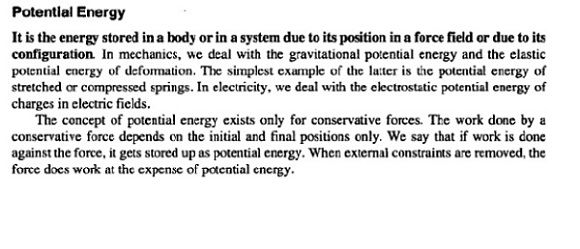

Textbook of Engineering Physics, Part 1
This is basic stuff, if don't understand this much (cut the B.S., you clearly do not) you have a lot of audacity taking the position that you have.
Friendly advice, do with it what you will.
Anok, in all sincerity, you would be well rewarded by taking a break from the 9/11 conspiracies and investing that time back into an online entry level physics course.
I wont bother going back to requote and correct the last couple of pages because it is so bad I have to believe you are either purposefully yanking some chains or you have never truthfully been anywhere near a physics textbook in your life.
To put the Pe question to rest once and for all (hopefully)...


Textbook of Engineering Physics, Part 1
This is basic stuff, if don't understand this much (cut the B.S., you clearly do not) you have a lot of audacity taking the position that you have.
Friendly advice, do with it what you will.
edit on 6-11-2011 by Drunkenparrot because: Sp
reply to post by plube
Salutations Plube, nice to see you again.
You may be interested in these or, then again, you may not as they contradict much of what you have posted ...
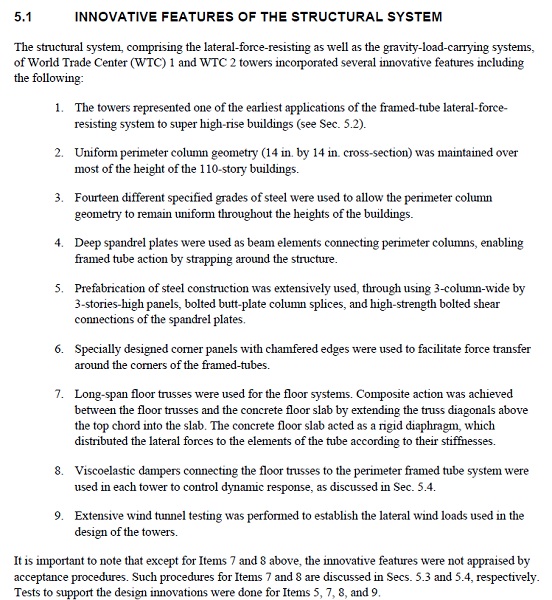
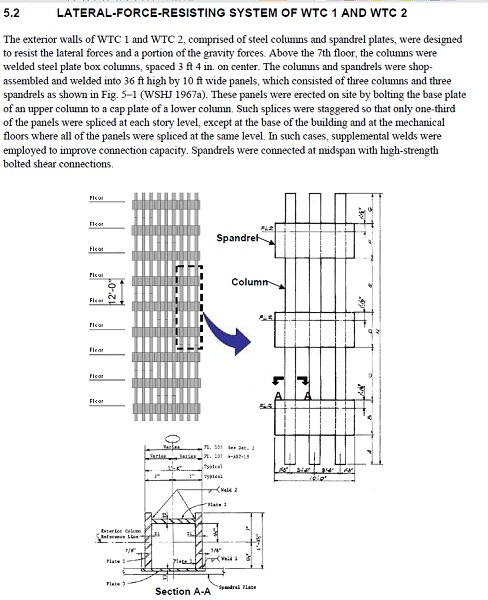
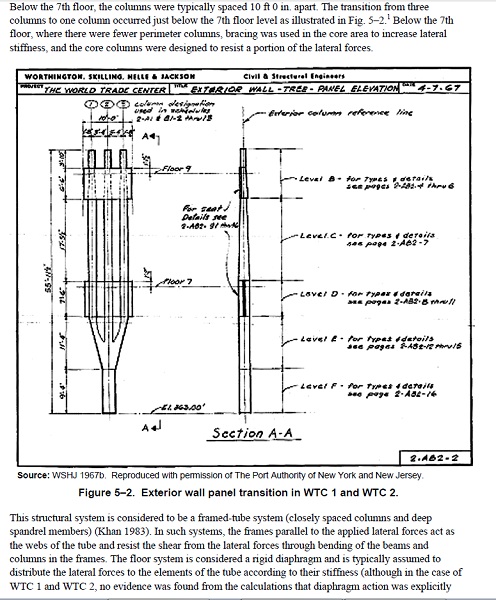

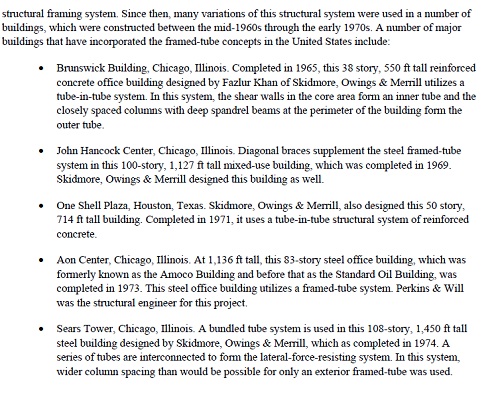
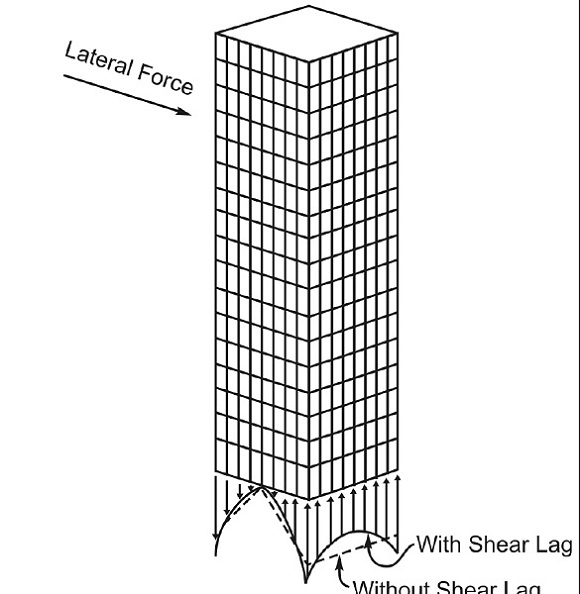
•NIST NCSTAR 1-1A: Design and Construction of Structural Systems
I don't believe it can be made any clearer than the following, lateral support was provided by the design of the shell.
The lateral support of the core was provided by the individual floor connections laterally braced by the exterior shell.
In short, remove the shell and the floors from the core and there is nothing to keep the core from falling over, but don't take my word for it...
There is an absolute wealth of information within the NIST reports, you should check it out sometime.
Edit to add:



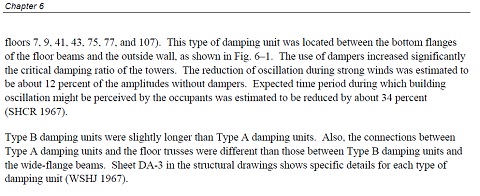
NIST NCSTAR 1-1: Design, Construction, and Maintenance of Structural and Life Safety Systems
I'll add some more shortly.
Salutations Plube, nice to see you again.
You may be interested in these or, then again, you may not as they contradict much of what you have posted ...






•NIST NCSTAR 1-1A: Design and Construction of Structural Systems
I don't believe it can be made any clearer than the following, lateral support was provided by the design of the shell.
The lateral support of the core was provided by the individual floor connections laterally braced by the exterior shell.
In short, remove the shell and the floors from the core and there is nothing to keep the core from falling over, but don't take my word for it...
There is an absolute wealth of information within the NIST reports, you should check it out sometime.
Edit to add:




NIST NCSTAR 1-1: Design, Construction, and Maintenance of Structural and Life Safety Systems
I'll add some more shortly.
edit on 6-11-2011 by Drunkenparrot because: Sp
reply to post by plube
Another quick note, the majority of the diagonal steel bracing you see in the core is temporary.
It is only there to keep things square and plumb and is removed as the core is poured and the floor trusses are tied in with the shell because then it is no longer necessary.
This is the case all the way from a 300 sqft addition in the back yard to, well, the World Trade Centers.
Your not doing yourself any favors here Plube.
You guys do know that cardboard box forts and birdhouses in high school shop class don't count far towards construction expertise don't you?
Another quick note, the majority of the diagonal steel bracing you see in the core is temporary.
It is only there to keep things square and plumb and is removed as the core is poured and the floor trusses are tied in with the shell because then it is no longer necessary.
This is the case all the way from a 300 sqft addition in the back yard to, well, the World Trade Centers.
Your not doing yourself any favors here Plube.
You guys do know that cardboard box forts and birdhouses in high school shop class don't count far towards construction expertise don't you?
reply to post by captainnotsoobvious
No you using the term "truther" shows your level of mentality... which is CHILD LIKE with a strong dose of denial. I don't use the term or anything like it and those that do have a very limited though capacity from the evidence presented in these foroms.
So after 9/11 the fact that we went to war and got the patriot act are all coincidence? Do you deny that this country is racing towards a one world government?
You're on fantasy island bro .. not us.. Please stop posting these lies it really makes me sick to my stomach to think that either you really are that stupid or your a disinformation agent for real..either way I'm puking ova here....
No you using the term "truther" shows your level of mentality... which is CHILD LIKE with a strong dose of denial. I don't use the term or anything like it and those that do have a very limited though capacity from the evidence presented in these foroms.
So after 9/11 the fact that we went to war and got the patriot act are all coincidence? Do you deny that this country is racing towards a one world government?
You're on fantasy island bro .. not us.. Please stop posting these lies it really makes me sick to my stomach to think that either you really are that stupid or your a disinformation agent for real..either way I'm puking ova here....
edit on 11/6/2011 by firegoggles because: sp. fix
Originally posted by Drunkenparrot
In short, remove the shell and the floors from the core and there is nothing to keep the core from falling over, but don't take my word for it...
No it wouldn't, you are just making an assumption.
Look at the core...
The core held up the floors, not the other way around. But regardless the core did not fall over did?
Your whole point is based in nonsense to begin with. The floors would not have collapsed the way you want to think they did.
This right here proves the floors were not the first thing to collapse, the core was...
The whole top section is moving as one, before the bottom starts to collapse. Collapsing floors would not cause either of those events.
The reason the tops tilted wasn't because of truss failure now was it? It was because the core failed, obvioulsy.
More evidence of core failure...
The antenna was on top of the hat truss, on top of the core. There is no other explanation for this other than core failure, not floor truss failure. If it was simply a truss failure, the floors would have been pinned between the so called inner bowing of columns. The floors were already tightly fitted against the inner and outer columns.
It would just add more resistance to the collapse.
reply to post by ANOK
When are you going to entertain us with your explanation of how sagging trusses cant result in a tension force on the outer columns ? The outer columns were defiantly pulled in just prior to the collapse. How did they do it ?
When are you going to entertain us with your explanation of how sagging trusses cant result in a tension force on the outer columns ? The outer columns were defiantly pulled in just prior to the collapse. How did they do it ?
Anok, the core construction was not designed to, nor would it be expected to stand unsupported beyond maybe a dozen stories.
Don't take my word for it, read through the data and look at the design for yourself.
ALL of the lateral load above the 7th floor was carried by the tube frame of the exterior shell with the core being braced laterally by the exterior shell via the floor truss assemblies.
This is not an opinion, it is clearly spelled out...



If the core is capable supporting itself as you believe and was only laterally braced below the 7th floor, what is resisting the overturning moment and other various lateral loads of the other 103 stories?
Don't take my word for it, read through the data and look at the design for yourself.
ALL of the lateral load above the 7th floor was carried by the tube frame of the exterior shell with the core being braced laterally by the exterior shell via the floor truss assemblies.
This is not an opinion, it is clearly spelled out...



If the core is capable supporting itself as you believe and was only laterally braced below the 7th floor, what is resisting the overturning moment and other various lateral loads of the other 103 stories?
Kudos to drunken parrot for major ass kicking in this thread. Lots of referenced reading and research goes into this. This is how it's done people.
Originally posted by Drunkenparrot
ALL of the lateral load above the 7th floor was carried by the tube frame of the exterior shell with the core being braced laterally by the exterior shell via the floor truss assemblies...
...If the core is capable supporting itself as you believe and was only laterally braced below the 7th floor, what is resisting the overturning moment and other various lateral loads of the other 103 stories?
Lateral bracing, not lateral or vertical loading. The floors provided lateral transfer of forces between the core and the outer mesh so they moved together in the wind, they did not hold the core up. If the core was going to fall from being unable to hold itself if would topple not fall vertically.
Lightweight trusses are not designed to brace columns from vertical force. The core needed no bracing from floors to stand, stop with the nonsense, no one is buying it. The core was the buildings backbone. It would take the failure of the core to cause complete collapse, not the other way around as you want to claim.
How many times are you going to keep reverting back to debunked nonsense to make your points?
The core did not need the floors to stand, period, just look at it...
The columns bellow the 7th floor they are talking about is the outer columns...
edit on 11/7/2011 by ANOK because: typo
BTW you all claim the floors and all the contents stayed within the footprints of the towers.
So how did this not stay within the footprint...
That is an elevator winch, that was in the core. So if that was ejected during the collapse, then what makes you think the concrete would also not be ejected during the collapses?
So how did this not stay within the footprint...
That is an elevator winch, that was in the core. So if that was ejected during the collapse, then what makes you think the concrete would also not be ejected during the collapses?
Originally posted by ANOK
BTW you all claim the floors and all the contents stayed within the footprints of the towers.
So how did this not stay within the footprint...
That is an elevator winch, that was in the core. So if that was ejected during the collapse, then what makes you think the concrete would also not be ejected during the collapses?
Well considering that:
These 72 photographs of the World Trade Center disaster site in New York City were taken by AP on 3 October 2001, about noon.
cf.parrhesia.com...
There's no telling if that's the actual resting place of that winch (3 weeks later) or if it had been temporarily placed there before being removed from the site. For all you know it could've been cleared from the pile that appears to be just yards away.
How many of those things do you suppose there were? Must've been like massive wrecking balls on the way down
Originally posted by ANOK
BTW you all claim the floors and all the contents stayed within the footprints of the towers.
So how did this not stay within the footprint...
That is an elevator winch, that was in the core. So if that was ejected during the collapse, then what makes you think the concrete would also not be ejected during the collapses?
Yea thats exactly where it landed, you can tell by the impact crater.
Did you also happen to notice that stack of pancaked floors in the background ?
edit on 7-11-2011 by waypastvne because: (no reason
given)
Originally posted by ANOK
BTW you all claim the floors and all the contents stayed within the footprints of the towers.
So how did this not stay within the footprint...
That is an elevator winch, that was in the core. So if that was ejected during the collapse, then what makes you think the concrete would also not be ejected during the collapses?
Hmm maybe it fell there when the top section of the towers was destroyed and bounded out. Or maybe it got ejected from the "footprint" when the high pressure from the collapse may have knocked it out. Or maybe it just bounced through the debris.
But ANOK, I'm STILL waiting for you to supply me with evidence of the majority of the mass being ejected outside the footprint. A picture of the floor assembly being thrown out, with the trusses, steel decking and concrete slab all being ejected out or even falling out connected to an exterior column or two. ANYTHING ANOK!!
Originally posted by ANOK
As I said the top would not have Pe until it was separated from the bottom, why is that hard to understand?
How did the top have Pe when it was still part of the rest of the building?
Again Pe is the energy of position of an object, not an object at rest as you claimed. Get the physics terms straight, and maybe you'll stop laughing like an ignorant hyena.
Maybe when the construction workers lifted all those trusses, columns, beams, concrete, etc etc etc to those heights, the PE increased and was stored? just like your quote below:
Potential Energy
An object can store energy as the result of its position.
www.physicsclassroom.com...
Well done "Mr. Physics". Completely forgot how the WTC were built. Forgot that the materials lifted up and put in place during construction actually stored PE.
You can not have energy if work has not been done, a resting object has no Pe, unless that object is suspended in the air, or has some internal mechanism to create energy itself. Argue and laugh all you want, you are wrong and have always been wrong, you're not smarter than a fifth grader...
So those materials were just magically "popped" into place during construction? I think even a 5th grader knows that in order to build something you have to put work into it. Lifting up tons of steel is definitely one of them.
Well done ANOK. I'm pretty sure whatever physics teacher you had would probably do a facepalm at reading this.
new topics
-
🐰Most INSANE internet rabbit hole🕳
Secret Societies: 8 minutes ago -
Joe Rogan conspiracy (maybe)
ATS Skunk Works: 3 hours ago -
Results of the use of the Oreshnik missile system in Dnepropetrovsk
World War Three: 6 hours ago -
Nigel Farage now the Most Favoured UK Politician
Regional Politics: 7 hours ago
top topics
-
Little Johnny and Larry should team up
General Chit Chat: 14 hours ago, 12 flags -
Results of the use of the Oreshnik missile system in Dnepropetrovsk
World War Three: 6 hours ago, 11 flags -
Nigel Farage now the Most Favoured UK Politician
Regional Politics: 7 hours ago, 4 flags -
Joe Rogan conspiracy (maybe)
ATS Skunk Works: 3 hours ago, 3 flags -
Will Us use alien technology to fight in ww3?
World War Three: 14 hours ago, 2 flags -
🐰Most INSANE internet rabbit hole🕳
Secret Societies: 8 minutes ago, 1 flags
active topics
-
Results of the use of the Oreshnik missile system in Dnepropetrovsk
World War Three • 144 • : Oldcarpy2 -
Nigel Farage now the Most Favoured UK Politician
Regional Politics • 8 • : angelchemuel -
-@TH3WH17ERABB17- -Q- ---TIME TO SHOW THE WORLD--- -Part- --44--
Dissecting Disinformation • 3354 • : Thoughtful3 -
🐰Most INSANE internet rabbit hole🕳
Secret Societies • 0 • : maferoxy2 -
Inca stone masonry at Sacsayhuaman, Ollantaytambo and the Sun Temple
Ancient & Lost Civilizations • 9 • : Astrocometus -
Post A Funny (T&C Friendly) Pic Part IV: The LOL awakens!
General Chit Chat • 7816 • : baddmove -
DOJ moving to wind down Trump criminal cases before he takes office
Mainstream News • 46 • : WeMustCare -
What Joe Rogan said Vs The View
Dissecting Disinformation • 23 • : cocnutcrab883 -
President-Elect TRUMP Picks Former Florida A.G. PAM BONDI to be U.S. Attorney General.
2024 Elections • 58 • : WeMustCare -
Well, here we go red lines crossed Biden gives the go ahead to use long range missiles
World War Three • 330 • : putnam6
